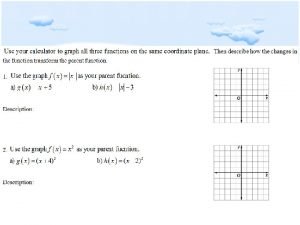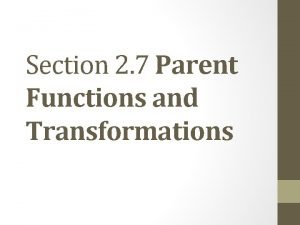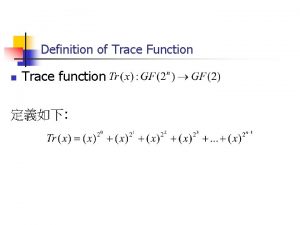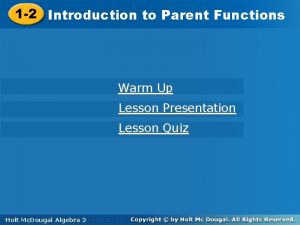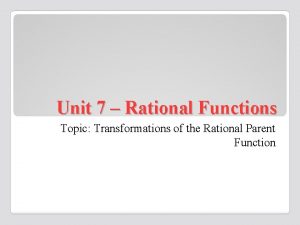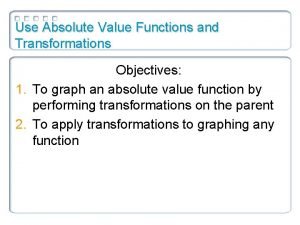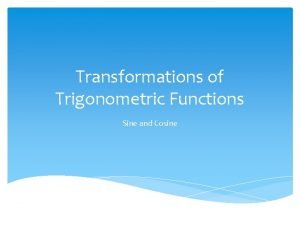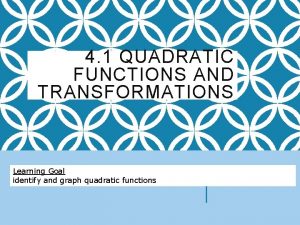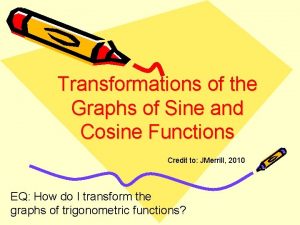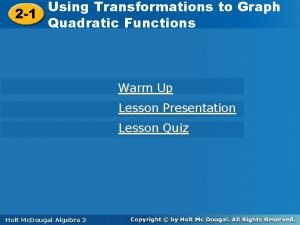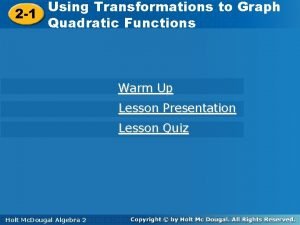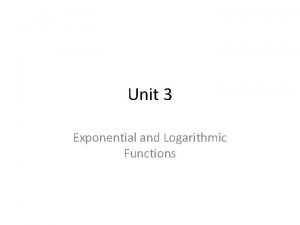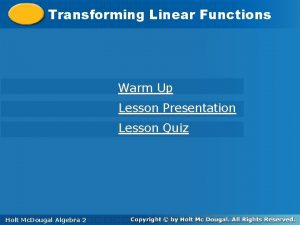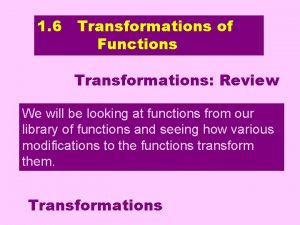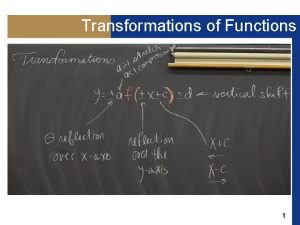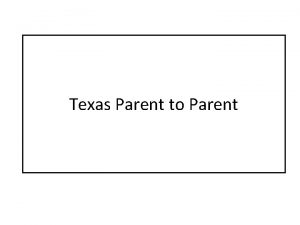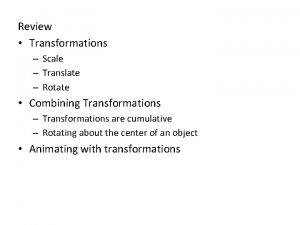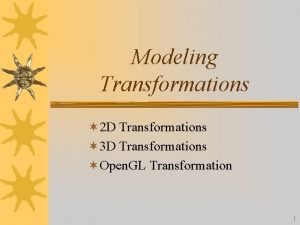Section 2 7 Parent Functions and Transformations A














- Slides: 14

Section 2. 7 Parent Functions and Transformations

• A family of graphs is a group of graphs that display one or more similar characteristics. The parent graph, which is the graph of the parent function, is the simplest of the graphs in a family. This is the graph that is transformed to create other members in a family of graphs.


• Example 1: Identify the type of function represented by the graph.

• Example 2: Using your calculator, graph the following, in this order: • a) Y 1 = |x| • b) Y 2 = |x| + 2, what do you notice? • c) Y 2 = |x| – 2, what do you notice? • d) Y 2 = |x + 2|, what do you notice? • e) Y 2 = |x – 2|, what do you notice?

• Example 3: Using your calculator, graph the following, in this order: • a) Y 1 = |x| • b) Y 2 = –|x|, what do you notice? • c) Y 2 = |3 x|, what do you notice? • d) Y 2 = , what do you notice?

• Transformations of a parent graph may appear in a different location, flip over an axis, or appear to have been stretched or compressed. The transformed graph may resemble the parent graph, or it may not. • • A translation moves a figure up, down, left, or right. • • *When a constant k is added to or subtracted from a parent function, the result f(x) ± k is a translation of the graph up or down. • *When a constant h is added to or subtracted from x before evaluating a parent function, the result f(x ± h), is a translation left or right.

• A reflection flips a figure over a line called the line of reflection. • *When a parent function is multiplied by – 1, the result –f(x) is a reflection of the graph in the x-axis. • *When a parent function is multiplied by – 1, the result f(–x) is a reflection of the graph in the y-axis. • A dilation shrinks or enlarges a figure proportionally. When the variable in a linear parent function is multiplied by a nonzero number, the slope of the graph changes. • *When a nonlinear parent function is multiplied by a nonzero number, the function is stretched or compressed vertically. • *Coefficients greater than 1 cause the graph to be stretched vertically, and coefficients between 0 and 1 cause the graph to be compressed vertically.

• Example 4: Describe the transformation in y = (x + 1)2. Then graph the function

• Example 5: Describe the transformation in y = |x| – 4. Then graph the function.

• Example 6: Describe the transformation in y = –|x|. Then graph the function.


• Example 8: Describe all transformations on y = 2|x – 3|+ 1. Then graph the function.

• Example 9: Which of the following is not an accurate description of the transformations in the function • • a) +4 translates f(x) = |x| right 4 units. • b) – 2 translates f(x) = |x| down 2 units. • c) translates f(x) = |x| across the x-axis • d) +4 translates f(x) = |x| left 4 units.
 Function family graphs
Function family graphs Describe the transformation from the parent function
Describe the transformation from the parent function Lesson 2-7 parent functions and transformations
Lesson 2-7 parent functions and transformations Parent functions and transformations
Parent functions and transformations Parent function project
Parent function project Function transformations
Function transformations Parent function for rational functions
Parent function for rational functions Absolute value graph transformations
Absolute value graph transformations Transformation of trigonometric functions
Transformation of trigonometric functions 4-1 quadratic functions and transformations
4-1 quadratic functions and transformations Transformations of sine and cosine functions
Transformations of sine and cosine functions Transformations of quadratic functions
Transformations of quadratic functions Translating quadratic functions
Translating quadratic functions Examples of exponential equations
Examples of exponential equations Transformation linear function
Transformation linear function
